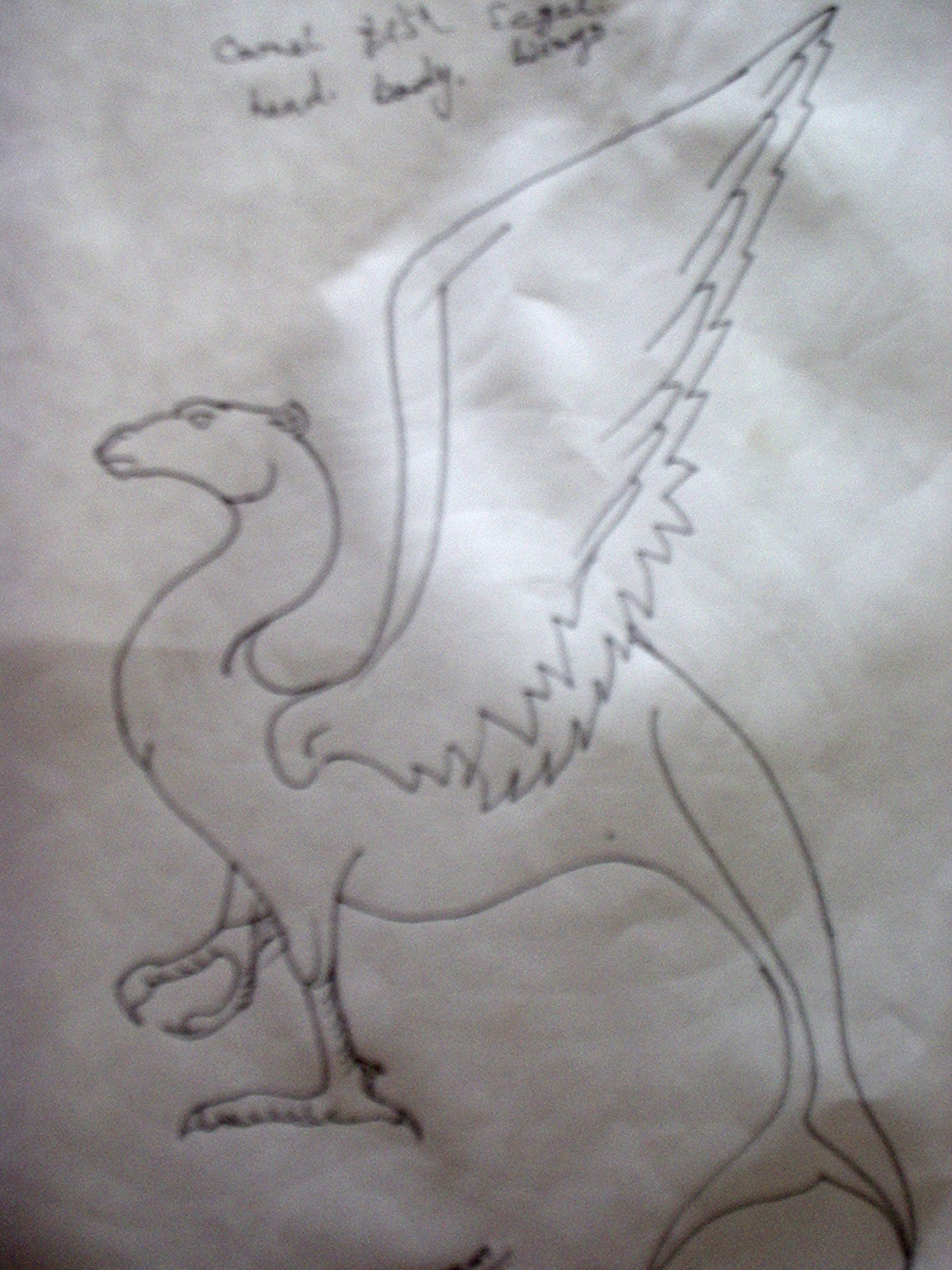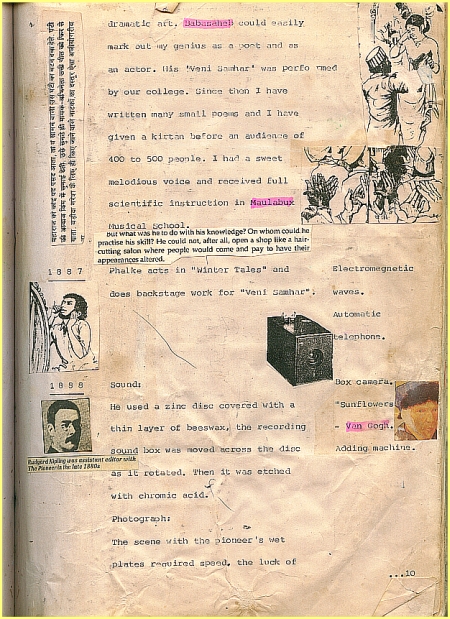1887
Sarasvatibai:
The Baroda that Govind came to..was a city where a sleeping dome might suddenly come alive with a halo of red beaked green parrots taking to the air. A clock in a tall tower said "Chimnabai, Chimnabai" every second it moved. The citizens of the city had named it after their large eyed dancing queen from Tanjore.. A long, many corridored, fairy palace had been breathed into life in the name of the same queen, who died young and so became, the old queen. The new queen was also called Chimnabai
Neelkanth:
That's why the clock said Chimnabai, Chimnabai.
Sarasvati:
Yes, the two wives with the same names, neither had met the other, they were seperated by the mirror surface of time. When one was talked of, the other was also turned her head, knowing she was remembered. The new queen also always stood just that much aside, each time her name was called, knowing she was not called alone.
And Sayaji was husband to both, Chimna and the absence of Chimna.
Neelkanth:
Chimnabai, chimnabai.
Sarasvati Bai:
Govind.. came to the magic city of Sayaji Maharaj's Baroda, the way Annasaheb would walk across the magical backdrops of Anandrao Patwardhan
Neelkanth:
Govind went to live in a palace?
Sarasvati: Govind lived in the palace grounds, with his brother who was the secretary of a big scholar, called Ramesh Chandra Dutta. He saw such grandeur in Baroda, lakes with swans, lawns with peacocks, and everywhere horses, with British names.
Mandakini:
Occident, Sally Gardner
On one of the walls of an old wada in Baroda, among the clusters of images, sacred and profane, a fantastic bird has come to make its home.
Ajab Guljohari Janwar.
the silent animal came with its own story of seeking, struggling with being and becoming.
Electromagnetic waves. Automatic telephone.
Phalke acts in "Winter Tales" and does backstage work for "Veni Samhar".
[[1]]
superstitions of the gandharvas- the theatre players, celestial beings The theatre cat is often watched closely. In any case, the animal must never be illustrated. But if the cat runs across the stage during a reherseal, disaster is almost certain to happen. When 'making up'each actor tries to use an individual mirror, for very bad luck falls on a player whose colleagues look over his shoulder at his reflection. In some cases it helps if you use soap belonging to a better? actor
The Naatak Company got a annual grant from the Gaekwad of Baroda. The company would preface its advertisements with "Blessed with the special protection of His Highness, Sayajirao Maharaj, the Gaekwad of Baroda". The Vankaner theatre of Baroda was used by the company to experiment with its plays in special shows to which only the King and his family were invited. Commoners were not allowed into these shows. A large curtain would be put up in the middle of the performance area. The king and other male members of the royal family would sit to one side of it, on the other side would sit the queen and other women of the family, beind the veil of a gauze curtain. The maids would also come to watch the play and if the play took off, they would lift the gauze veil and enjoy the play some more. A specially soft sofa was brought from the palace for the king. Once, before the play started, I had tried sitting on that sofa, it was really very soft. Someone told me it has mattresses made of bird wings. That special sofa that was got for the Maharaj had a small bell kept near it. If a particular scene of song appealed to the audience, they had no leave to applause, in fact an odd silence would always prevail. Absolute silence.
I remember when "Shakuntal" was going to be shown. Because of having hurriedly prepared this experiment, none of the players had really managed to learn their dialogues. Everyone had readied to do the performance by depending on the prompter. In both wings, behind two more curtains one, in this way three prompters per wing were furthering the show. That play was full of songs. Not just Shakuntala, but Dushyant also had many songs to sing.
Because of Durvasa's curse, Dushyant forgets Shakuntala. Later on a ring he had given Shakuntala is found by a fisherman. He takes the ring to the king. The king remembers her again and is overtaken with sorrow and guilt..Overtaken by longing in this chapter, Dushyant sings not one of two, but five six songs. In that griefstricken state Dushyant makes a portrait of Shakuntala. And I am the poor Sanumati who stands before the king, holding Shakuntala's portrait. I was given strict instructions to hold the portrait in such a way that the audience should not be able to see it. What was the reason for this? That that was not Shakuntala's portrait at all. Instead the lines of the verse that Dushyant was to sing were written on the 'canvas'. On the one hand the senior actor who played Dushyant took on each verse, stretching out the lines, savouring it, and at the same time I began succumbing to my old habit of falling asleep when such tendentious singing commenced. My neck began to bend with the weight of sleep. As a result, as the song progressed, the 'portrait' travelled, sometimes up, sometimes down, this way and that. The actor grabbed the portrait from my hands, my eyes flew awake. He gave me one angry glance and then lapsed into his sad song again. And the rest of the performance went on as planned.
while portraiture was becoming the new valued art form in art schools and high society alike..there was a percolation within the middle classes too. If the rich were getting portraits painted, the middle class were keen to get photographs taken, portrait photography. So there were art school students setting up studios, and if they could not afford that, being employed to tint photographs in commercial studios.
No matter how skilled the painter, his work was always in fee to an inescapable subjectivity. The fact that a human hand interveneed cast a shadow of doubt over the image. Again, the essential factor in the transition from the baroque to photography is not he perfecting of a physical process(photography will long remain the inferior of painting in the reproduction of colour); rather does it lie in a psychological fact, to wit, in completely satisfying our appetitie for illusion by a mechanical reproduction in the making of which man plays no part. The solution is not to be found in the result achieved but in the way of achieving it.
ab
Photography aaffects us like a phenomenon in nature, like a flower of snowflake whose vegetable or earthly origins are an inseperable part of their beauty.
ab
His mother's sudden death makes Abalal leave Bombay, where has been studying painting under Griffith, and return to Kolhapur. He will become the prototype for a new myth that is to permeate art circles- of the artist as as struggling individual who works in the pursuit of a higher ideal alone. He will be remembered for his miniature( that is all he could afford to paint) landscapes of the Kolhapur countryside. At some point, he also takes to photography to supplement his income.
Gauhar Jaan leaves with her love, Chaggan, for Banaras.

